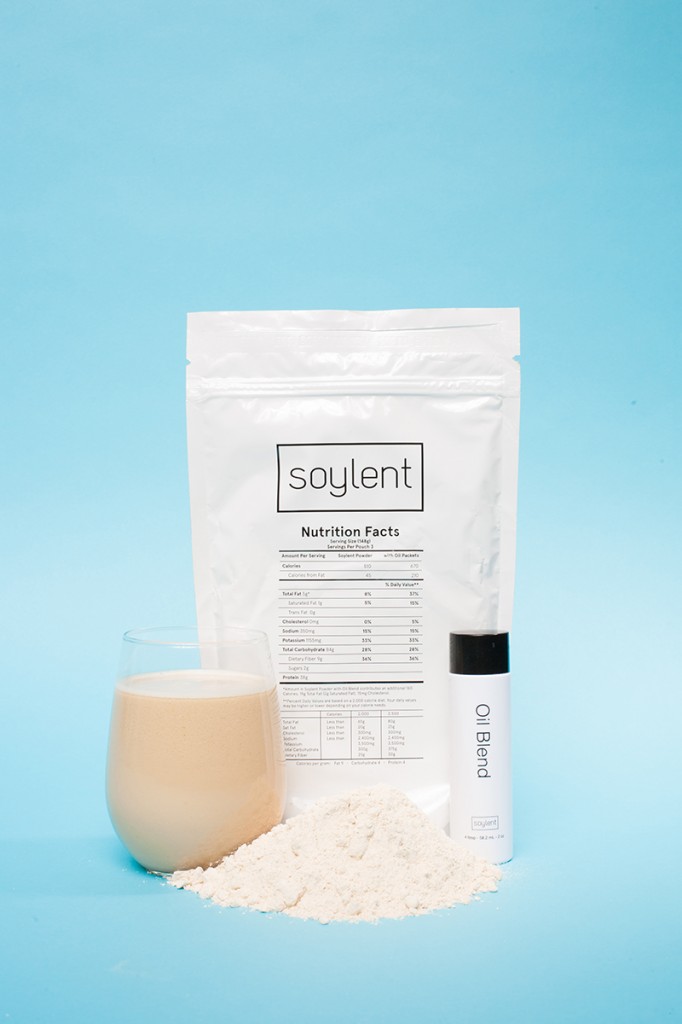Soylent alternatives around the world, part 1
What are the Soylent alternatives if you don’t want to go for DIY? We broke it down for you!
Part 2 can be found here.
Edit: the first versions of this article contained some incorrect or misleading information. After receiving feedback from readers and distributors, we corrected the information here and produced this Errata explaining what was wrong. As always, feel free to contact us if you find any other inconsistencies in this article.
Soylent quickly gathered a fair amount of hype, which caught the interest not only of enterpreneurial speculators, but after the release of DIY Soylent tool even of the masses. Hence there currently exist several commercial alternatives (“distros”) of powdered and liquid foods. Let’s shortly introduce the first six of such products:
and think about few pros and cons of the individual variants.
Soylent

Make room for Soylent!
Source: Soylent press kit
Rob Rhinehart, software engineer from Atlanta, created this product around the beginning of the year 2013 and ignited all this fuss. First regular orders started to ship in May 2014. Simultaneously, he created the already mentioned DIY Soylent Tool, by means of which theoretically anyone can create a similar drink. The name “Soylent” references a book called Make Room! Make Room! by Harry Harrison, which has later been adapted into movie Soylent Green. This choice of name is either ill-judged (spoilers: Soylent Green in the movie is made out of human remains) or quite astute (it certainly helped the virality). Moreover, thanks to the name, it’s somehow natural to presume that the main component of the Soylent is soy, which simply isn’t true (it contains soy, but only in a relatively small amount of soy lecithin).

Rob himself
Source: Soylent press kit
Price: $9.10 (7.30 EUR) per day
Pros
- first, “official” recipe – it’s the oldest on the market and probably has “the largest body of science” backing it up
- you can find lots of real experience of people eating Soylent all over the internets
- huge media response = many reportages = higher pressure on the quality of the production. Example here.
Cons
- the company has been overwhelmed by the huge demand, thus the delivery has been delayed – new orders are supposedly shipped 2-3 months after placement (at the time of publication of this post) and they ship only within the USA
- the price is currently a bit too high (when compared to DIY and European alternatives), but Rob plans to bring it down to 5 dollars
- carbohydrates are derived from the maltodextrin, which has high glycemic index, is absorbed quickly and theoretically can cause higher fluctuation of blood sugar
- there’s only one version of Soylent so far – no customization based on age, weight or amount of physical activity is possible. You fancy the low-carb diet? Tough luck
Mana

Soyl…err, Mana!
Source: Mana press kit

Jakub Krejčík in a lab
Source: Mana press kit
Let us jump from behind the ocean right to our nearest border – Czech guy Jakub Krejčík (and his colleagues) invented his own powdered food called Mana. He chose to name it after biblical food sent to Israelites by God while they wandered in the desert (or he was, well, inspired by the computer games). This caught the media attention mainly in the Czech Republic and Slovakia, but the sales are not limited to these two regions.
Price: $8.15 (6.50 EUR) per day
Pros
- looking at the official Mana blog it seems that the authors take it seriously and profesionally with all the appropriate tests and stuff. Example here (only in Czech, unfortunately)
- local (Czech) product – I can complain about my gases in Slovak language
- the exact list of ingredients is available on their webpage (which, regrettably, doesn’t go without saying)
Cons
- they were overwhelmed by demand too. The shipping delay was originally 8-10 weeks (as stated back then on their website); now is said to be 2-3 weeks for new customers (as stated now)
- cheaper than Soylent (which doesn’t ship to Europe), but still a bit too high
- maltodextrin!
- the proteins are acquired mainly from soy, which is the inception of all conspiracy theories about phytoestrogens and genetically modified organisms. Whether you believe them is up to you
- only one version available, similar to Soylent
Web: http://mymana.eu/
Joylent

Joylent
Source: Joylent Facebook page

Joey working
Source: Joylent Facebook page
Product of a former drug dealer from Netherlands Joey van Koningsbruggen is labeled by himself as “European response to Soylent”. He began shipping quite early – summer 2014 – and currently is doing just fine. Joey gathers his customers not only with the help of low price and bigger sortiment, but also with a peculiar sense of humour with which his web is interwoven. A small sample:
“Use Joylent as the ultimate hangover food, while taking a shower, when you go into the forest for three days without knowing anything about berries or mushrooms, when you’re watching TV, when you’re hanging on the street corner with your friends, when you’re riding your bike, when you’re taking a shit, when you’re in therapy talking about your daddy issues, and when eating together with your dog.”
Moreover, the law apparently doesn’t give any headaches to Joey, as when he was asked by reporter whether he has to live up to certain government criteria he replied “I do not know, I have not checked”. To be fair, the Dutch food authorities later stated that they do not plan to visit Joey (that’s a nice government, isn’t it?).
Price: $6.45 (5.15 EUR) per day
Pros
- considering the price this is the cheapest European alternative to Soylent – if you don’t plan to create your own formula
- four flavours – banana, chocolate, vanilla and strawberry
- the initial shipping delay is supposed to be 2 weeks
- the complete ingredient list can be found in their FAQ
Cons
- the recipe is homemade with the help of DIY Soylent tool. Food technologist joined the Joylent team only in August
- there is no mention of sulphur in the nutritional facts
- maltodextrin!! soy flour!!
- I haven’t tried Joylent yet (btw: we’ll gladly exchange a sample of Synectar for a sample of Joylent!), but the absence of a neutral flavour is something to ponder. After all, there are people who don’t like additional flavourings, viz. Pavol
100% Food

100% Food
Source: Space Nutrients Station Facebook page

This doesn’t look like the worst job ever though
Source: Space Nutrients Station Facebook page
American DIY alternative from Aleh Manchuliantsau bets his marketing on the Space – he markets his powder as “food of the astronauts”. Except a “normal” version he offers a version with double protein amount (for the bodybuilders), low-carb version (less carbohydrates, more fats and protein) and low-sugar version (i.e. the carbs contain less sugar). Besides that he constructed his own food automat – Wesna (you gotta check the video – it’s like we live in the future!).
Price: from $8.93 (7.15 EUR) per day
Pros
- they send it in very nice little bottles – already pre-weighed to individual meals so you only have to add water and shake it. They don’t even use oil! Fats are instead provided by flax seeds, hemp hearts and soy lecithin
- two flavours: “organic” and “chocolate” + four versions with different macronutrient ratios
- they ship to EU
- sometimes they offer so-called “21 flavours set” – they ship 21 experimental flavours of 100% Food, very unusual flavours, I must say. For example: “soup with bacon”, “pizza”, “walnut cookies” or “borsch”
- the exact list of ingredients with comments can be found here
Cons
- a heap of plastic bottles (as a default packaging option) probably wouldn’t please the environmentalists – but they offer plastic bags instead upon request, so this is only “half a con”
- the complete list of ingredients isn’t the easiest information to find – I only found it after the Spaceman himself pointed them out to me
- soy protein! – though only in Double Protein and Low Carb versions (100%Food Organic and Choco use hemp seeds and rice flour) and supposedly Non-GMO (as per this)
Web: http://www.spacenutrientsstation.com/
People Chow

People Chow – the amount of cocoa increases in the right direction
Source: People Chow website
Chris Bair polished (with the help of DIY Soylent tool) currently the most popular American DIY recipe (originally created by another redditor going by the monicker MaxK), so it’s only natural that he sells the prepared mix. The overall feeling of the site is “sincerity” – Chris isn’t pretending to be someone he’s not, he’s just doing what he likes and it seems he doesn’t mind if you “bypass” him and prepare the People Chow at home on your own. He offers “normal” and “low-cal” version and will add some cocoa powder to your order for a mini surcharge.
Price: $7.42 (5.72 EUR) per day
Pros
- low price considering the USA market
- two versions (normal and low-cal) plus the option to have cocoa powder mixed in
Cons
- homemade by one person, as far as I can tell. On the other hand, he’s not trying to fool you
- the oil (canola or olive) is not included, which raises the price per day
- he’s not shipping to EU
- some vitamins are really over the top (1000 – 3000% of RDI) – for example B6, B12, thiamin and riboflavin
Web: http://www.thebairs.net/product-category/people-chow/
Ambronite

Ambronite
Source: Ambronite website
We have a curiosity for you right here at the end – despite still being in the preorder phase (with estimated shipping of February 2015), the Finnish Ambronite is certainly worth mentioning – it claims it’s “organic”. Which means that it supposedly isn’t made of any artificial highly processed extracts and ingredients like the other powdered foods, but of 20 “normal” organic foods.
Price: $35.60 (28 EUR) per day
Pros
- looks serious and there’s not just one individual behind this (whole 5 people, whoo!)
- organic-vegan-nonGMO-glutenfree-artificialitiesFree, dayum!
Cons
- current price is quite repulsive, so let’s hope mass production fixes this
- living solely on Ambronite (4 packs a day) will give you 50mg of iron per day (actually, this information comes from the Ambronite website. In email from Mikko Ikola, co-founder of Ambronite, he states the recipe in production already contains less iron and the Ambronite team is working on its decrease). The recommended dosage for men is 8-10mg per day, 18mg per day for women. Studies haven’t found the exact value of “too much iron”, but for now the safety threshold is 45mg (here are all the thresholds in the most unreadable form). The problem of iron dwells in the fact that our bodies cannot normally dispose of any iron, only through a loss of blood.
- some other minerals and vitamins are quite over the top (nutritional info is here, scroll down), for example manganese and B1
- the shelf life is six months (Ars Technica article lists two months, which is, according to Mikko, simply a mistake). Such a shelf life might not be a problem at all, but the non-organic alternatives can supposedly easily last a year or two (thus are probably better for preppers!)
Stay tuned…or tunas
In the next (and the last) part we’ll talk about other currently hyped distros. So, until next time!
Disclaimer: if you have found any incorrect information or you have additional notes to text or images, or you have specific copyright claims on the images used in this article, please feel free to contact us. If you are the producer or the distributor of one of these products and want us to review your product more closely, feel free to contact us too.
